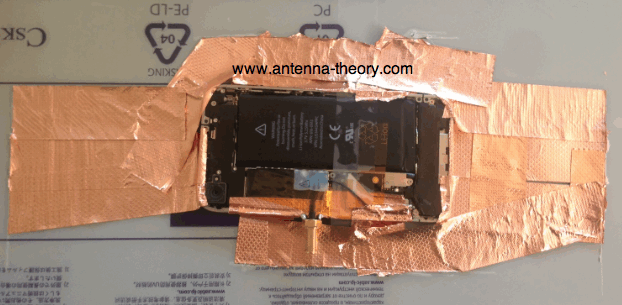|
It is well known that the iPhone 4/4S has an external cellular antenna.
It is also well known that increasing the size of an antenna will increase
its overall
antenna gain.
We use the above two facts to design a case that will electrically
contact and therefore extend the size of the cellular antenna - therefore
increasing the range!
How do you know this will work?
That's actually pretty simple. First,
we simply measure the primary cellular antenna on the iPhone as shown:

Figure 1. iPhone 4 - Cabled into the Primary Cellular Antenna.
And then we add copper tape to the external stainless steel antenna as shown below (note that this is not the actual copper layout, as I don't want to give away all the knowledge for free just yet):

Figure 2. iPhone 4 - Expanded Cellular Antenna.
By comparing the measured antenna gain before and after the simple modification
in an anechoic chamber,
we can directly see the increase in performance!
Does this work?
Yes. Here is an approximate measurement for increase in antenna gain over the cellular frequencies of the iPhone 4 and 4S.
Note that the average increase is 100%, or 3 dB:

Figure 3. iPhone 4 - Cabled into the Primary Cellular Antenna. Top Chart: Lowband Gain Increase. Lower Chart: Highband Gain Increase.
From Friis Transmission Formula,
we see that 100% increase
to the antenna gain will increase the range by about 41%
(so that if you have service at 1 kilometer, you will still have service on average
at 1.4 kilometers). For some frequencies the gain is 150%, which will further
extend the range.
Analysis
If you know about antenna theory, it is not clear the above would work. By making the antenna
longer, we do expect to increase the antenna gain. However, it is also possible that
we would have detuned the antenna, making it radiate well at lower frequencies. Fortunately,
this was not the case. The gain improvement derives from an approximately 0.5 dB
increase in antenna efficiency, along with a slightly more
directional radiation pattern.
Did you ever hear of those old Griffin cases from 2008 for the original iPhone? They
added a small stub and claimed to get cellular improvement. They were completely misleading people
and hopefully someone will sue them. In some of there claims, they suggest a 20 dB improvement in signal level -
absolutely absurd! As you can see from Figure 2, I had to greatly extend the length of the antenna
in order to get 3 dB of improvement.
And what about radiation exposure, or SAR?
Would such an antenna extension increase your radiation exposure? It turns out - no. The iPhone continues
to transmit a fixed amount of output power. As the antenna grows, that power is spread over a larger section than
normal (i.e. the electric current is not limited to just the size of the phone). As a result, this actually
despreads the radiation absorption intensity, lowering your overall SAR. Basically, since the antenna becomes very large, more of the energy
will scoot past your head than previously. So that is a plus.
This project is currently on the crowdfunding sight
indiegogo, so if you're interested, support the cause!
Thanks.
Antenna-Theory.com (Home)
This page on the iPhone 4/4S cellular range extender is copyrighted. No portion can be reproduced without the author's permission.
| 
